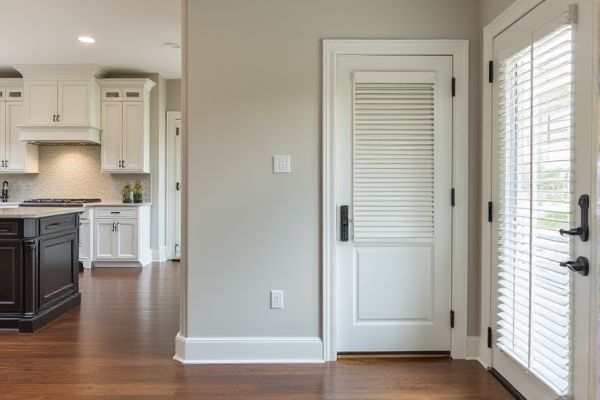
Louvered pantry doors offer improved ventilation and airflow, helping to keep food fresher by reducing moisture buildup, while solid doors provide better privacy and a sleeker appearance by fully concealing pantry contents. Explore the rest of the article to discover which door option best suits your kitchen's style and functionality needs.
Table of Comparison
| Feature | Louvered Pantry Door | Solid Pantry Door |
|---|---|---|
| Ventilation | Allows airflow, prevents moisture buildup | No airflow, seals pantry tightly |
| Privacy | Partial visibility through slats | Complete privacy, hides contents |
| Style | Traditional, decorative slats | Modern, clean, solid surface |
| Maintenance | Harder to clean due to slats | Easy to wipe and maintain |
| Durability | Slats can be fragile | Generally more durable |
| Price | Moderate cost | Varies, often less expensive |
| Best Use | Ventilated storage, humid climates | Secure storage, minimalist designs |
Introduction to Louvered and Solid Pantry Doors
Louvered pantry doors feature horizontal slats that allow air circulation, reducing moisture buildup and preventing mold growth inside the pantry. Solid pantry doors provide a fully enclosed, opaque barrier that offers better sound insulation and a cleaner, more uniform appearance. Choosing between louvered and solid doors depends on ventilation needs and aesthetic preferences in kitchen design.
Design Differences: Louvered vs Solid Pantry Doors
Louvered pantry doors feature angled slats that allow air circulation, preventing moisture buildup and promoting ventilation, which is beneficial for food storage areas. Solid pantry doors provide a sleek, seamless appearance that offers complete privacy and better sound insulation within the kitchen space. The choice between louvered and solid doors impacts both airflow management and aesthetic style, influencing overall kitchen functionality and design cohesion.
Ventilation and Airflow Benefits
Louvered pantry doors provide superior ventilation and airflow compared to solid doors, allowing air to circulate freely and preventing moisture buildup that can spoil food. This enhanced ventilation helps maintain a fresher environment for your pantry items, reducing the risk of mold and mildew growth. Choosing a louvered door optimizes air exchange, which is particularly beneficial in humid climates or kitchens without strong ventilation systems.
Privacy and Light Control Comparison
Louvered pantry doors offer partial visibility and ventilation through angled slats, allowing light and air to pass while maintaining some privacy. Solid pantry doors provide complete privacy and block all light, creating a fully enclosed space for your pantry. Choosing between the two depends on whether you prioritize airflow and subtle light filtering or total concealment and darkness for your storage area.
Aesthetic Appeal and Style Options
Louvered pantry doors offer a distinctive aesthetic appeal with their slatted design, allowing for ventilation and a more textured, airy look that complements coastal, farmhouse, and traditional interiors. Solid pantry doors provide a sleek, clean silhouette ideal for modern, minimalist, or transitional styles, enabling a seamless integration with cabinetry and wall finishes. Both options come in various materials and finishes, but louvered doors emphasize decorative detail and breathability, while solid doors prioritize uniformity and visual simplicity.
Durability and Maintenance Considerations
Louvered pantry doors offer better ventilation, reducing moisture buildup and potential mold growth, but their slats can accumulate dust and require more frequent cleaning compared to solid doors. Solid pantry doors provide superior durability due to their sturdy construction, making them less prone to damage and easier to maintain with simple wiping. Choosing between them depends on balancing airflow needs against ease of upkeep and long-term durability.
Cost Comparison: Louvered vs Solid Doors
Louvered pantry doors typically cost between $50 and $150 per door, offering better ventilation and a unique aesthetic, while solid pantry doors range from $75 to $200, providing enhanced privacy and sound insulation. The price difference largely depends on materials such as wood, MDF, or composite, with solid wood doors generally commanding higher prices. Choosing between louvered and solid doors involves balancing budget constraints against design preferences and functional needs like airflow versus noise control.
Installation Process and Complexity
Louvered pantry doors typically require careful alignment of slats during installation to ensure proper ventilation and aesthetic appeal, which can be more intricate compared to solid doors. Solid doors offer a straightforward installation process due to their simpler design and fewer components, making them ideal for quick and easy setup. Both door types necessitate standard tools and hardware, but louvered doors may demand extra precision to avoid gaps and maintain structural integrity.
Best Uses for Each Door Type
Louvered pantry doors are ideal for areas requiring ventilation, such as kitchens with humidity or appliances generating heat, as the slatted design promotes airflow and prevents moisture buildup. Solid pantry doors provide superior privacy and sound insulation, making them well-suited for open-concept spaces or rooms where you want to hide clutter and maintain a sleek, uniform appearance. Choosing between these door types depends on your need for ventilation versus aesthetic control in your pantry space.
Choosing the Right Pantry Door for Your Home
Louvered pantry doors offer enhanced ventilation, preventing moisture buildup and keeping your food fresher, while solid doors provide superior privacy and a cleaner, more streamlined look for your kitchen. Your choice depends on balancing airflow needs with aesthetic preferences and the level of insulation desired for the pantry space. Consider how louvered designs improve air circulation versus the solid door's ability to better conceal pantry contents and reduce noise.
 homyna.com
homyna.com